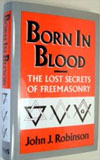 My Lodge was fortunate enough to have Bro Kent Henderson from Australia give a presentation in our hall yesterday. Bro Henderson is a Past Grand Master of Australia, and prolific Masonic author, editor and teacher. He is currently on a speaking tour through several countries and my Lodge held a large banquet for this occasion.
My Lodge was fortunate enough to have Bro Kent Henderson from Australia give a presentation in our hall yesterday. Bro Henderson is a Past Grand Master of Australia, and prolific Masonic author, editor and teacher. He is currently on a speaking tour through several countries and my Lodge held a large banquet for this occasion.
His presentation was on “The First Degree Around the World”. He spoke on the differences from the Emulation Workings in England, the Webb-Form rituals in the U.S., to various European Workings such as The French Rite and the German Schroeder Ritual.
It was a fascinating presentation and I was quite amazed at all of the differences from location to location in English speaking Freemasonry. I thought that it was confusing here in Alberta because Lodges follow either the Canadian Rite Ritual or the York Rite Ritual. I was surprised to hear that there are over 50 recognized English speaking Rituals being followed today!
Some of the Rituals can be quite different from ones here in North America. The actual degree work can be varied with different symbolism, procedures and even different teachings at the degree levels.
The bottom line for English speaking Freemasonry, is that by the time a man becomes a Master Mason anywhere, he will have the same moral instruction and understandings. It may be taught differently in a different order and with different symbolism, but it still gets the job done. Also, even though a Master Mason might travel and visit another Lodge anywhere in the world, he will still be able to understand what is going on, even if the Ritual is different.
The most controversial aspect of his presentation were his views on how to “raise the bar” on the level of Freemasonry. He spoke in detail about the European Ritual and payed the most attention to German Freemasonry. Here are some points about Lodges that follow the European Ritual:
1. Lodges take up to a year to decide if a candidate will be initiated.
2. 50% of applicants are rejected after thorough investigation.
3. At the start of the initiation ceremony, the Initiate fills out a questionnaire with some basic philosophic questions. This is then taken in a read to the lodge, who then vote on whether he can continue. If his answers are not “deep enough” he is rejected at this point.
4. Initiation fees are around $1000 and yearly dues are around $1000. The Candidate needs $2000 in hand to be initiated. (Canada, Australia and the United States have dues that are basically the same since World War 2)
5. Some Lodges will not accept a man if he does not have a University Degree. They feel that a man is not intelligent enough to understand Freemasonry’s teachings without a previous demonstration of intelligence.
6. It is common for a Mason to take 5 years to become a Master Mason.
7. All Masons are required to present several Masonic research papers at each level.
8. Before a Mason can be considered for the next degree, the Lodge votes on it. If he has not proved his knowledge of the current degree through his presented papers and lodge discussions, he will not be allowed to move on and will wait 6 months before he is voted on again.
9. Festive Boards after meetings are very impressive, fine-dining experiences. There would never be a hot dog in sight.
10. If you miss 3 meetings in a row, you are suspended. If you miss 5, you are expelled.
11. Lodges meet every week for nine months of the year.
Despite all of this, Freemasonry is growing in Europe! He even spoke about one Lodge that did not have a member resign since 1939.
He believes that if we make Freemasonry an Elite club that is very difficult to get into, it will increase the demand. If Masons spend more money in Lodge dues and have spectacular events every week, then they will have more pride in their lodges as well.
It does give one something to think about…
This is my 28th post on Freemasonry and my experiences as a Freemason. Here is the Table of Contents of my Masonic Journey.

 The other night I went through my final practice before my 3rd Degree Ceremony. The Degree Team was holding their regular practice that night at the Lodge, and I was allowed to rehearse my part with them.
The other night I went through my final practice before my 3rd Degree Ceremony. The Degree Team was holding their regular practice that night at the Lodge, and I was allowed to rehearse my part with them. I have two weeks left before I will go through my Third-Degree ceremony and become a Master Mason. I thought that I would commemorate that with a little Bling-Bling.
I have two weeks left before I will go through my Third-Degree ceremony and become a Master Mason. I thought that I would commemorate that with a little Bling-Bling. My Lodge has decided to have each of our Fellowcrafts go through the Master Mason degree individually. My degree ceremony will be held in about 5 weeks time, and I will be the third of my group to go through.
My Lodge has decided to have each of our Fellowcrafts go through the Master Mason degree individually. My degree ceremony will be held in about 5 weeks time, and I will be the third of my group to go through.  I was recently given the material that I need to memorize before I can become a Master Mason. I will need to show proficiency in my current degree of a Fellowcraft Mason before I can proceed to the third degree of Master Mason. My Lodge follows the Canadian Rite, so my exact requirements will vary slightly from other Freemason Lodges around the world.
I was recently given the material that I need to memorize before I can become a Master Mason. I will need to show proficiency in my current degree of a Fellowcraft Mason before I can proceed to the third degree of Master Mason. My Lodge follows the Canadian Rite, so my exact requirements will vary slightly from other Freemason Lodges around the world. A few people recommended that I read “Born in Blood, The Lost Secrets of Freemasonry”. I realize that this book has probably been talked about and debated by Masons in the last 18 years since it was first published, but it was new to me and it was a very interesting read.
A few people recommended that I read “Born in Blood, The Lost Secrets of Freemasonry”. I realize that this book has probably been talked about and debated by Masons in the last 18 years since it was first published, but it was new to me and it was a very interesting read. I am now officially a Fellowcraft Freemason! I no longer wear the plain white lambskin apron, but now my apron has two sky-blue rosettes at the bottom. I was just “passed” to the degree of a Fellowcraft in the Canadian Rite.
I am now officially a Fellowcraft Freemason! I no longer wear the plain white lambskin apron, but now my apron has two sky-blue rosettes at the bottom. I was just “passed” to the degree of a Fellowcraft in the Canadian Rite.  In a few more days, I will be be a Fellow Craft Freemason. The notice from my Lodge says that I will be passed to the degree of Fellow Craft, if found proficient in the work of the former degree.
In a few more days, I will be be a Fellow Craft Freemason. The notice from my Lodge says that I will be passed to the degree of Fellow Craft, if found proficient in the work of the former degree. At my last Lodge meeting, an informational letter was read from our Grand Lodge that dealt with the expulsion of a Brother. He had been convicted of a crime and had admitted his guilt and as such, all rights and privilages he had enjoyed in his Lodge or in the fraternity in general were now revoked.
At my last Lodge meeting, an informational letter was read from our Grand Lodge that dealt with the expulsion of a Brother. He had been convicted of a crime and had admitted his guilt and as such, all rights and privilages he had enjoyed in his Lodge or in the fraternity in general were now revoked.
